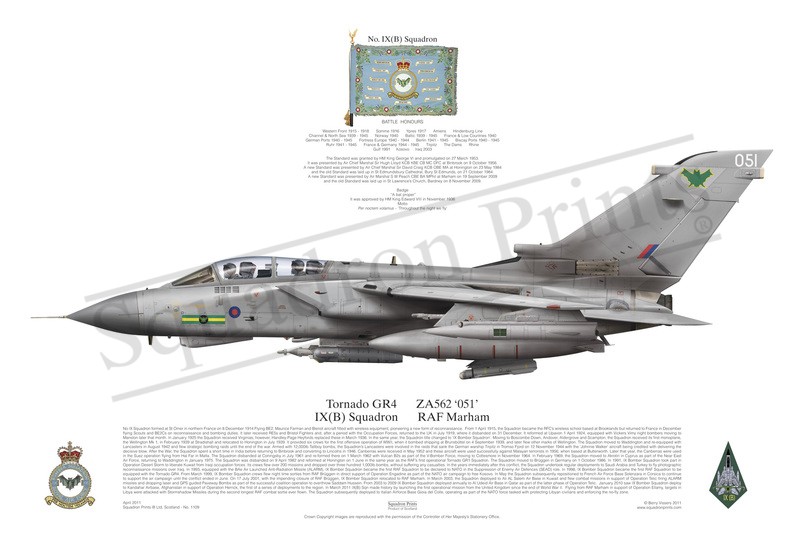#1109 Tornado GR4

Purchased products will not feature the Squadron Prints watermark
Description
Squadron Prints Lithograph No. 1109 - Tornado GR4, ZA562 \'051\', IX(B) Squadron, RAF Marham.
No IX Squadron formed at St Omer in northern France on 8 December 1914 Flying BE2, Maurice Farman and Bleriot aircraft fitted with wireless equipment, pioneering a new form of reconnaissance. From 1 April 1915, the Squadron became the RFC’s wireless school based at Brooklands but returned to France in December flying Scouts and BE2Cs on reconnaissance and bombing duties. It later received RE5s and Bristol Fighters and, after a period with the Occupation Forces, returned to the UK in July 1919, where it disbanded on 31 December. It reformed at Upavon 1 April 1924, equipped with Vickers Vimy night bombers moving to Manston later that month. In January 1925 the Squadron received Virginias; however, Handley-Page Heyfords replaced these in March 1936. In the same year, the Squadron title changed to ‘IX Bomber Squadron’. Moving to Boscombe Down, Andover, Aldergrove and Scampton, the Squadron received its first monoplane, the Wellington Mk 1, in February 1939 at Stradishall and relocated to Honington in July 1939. It provided six crews for the first offensive operation of WWII, when it bombed shipping at Brunsbüttel on 4 September 1939, and later flew other marks of Wellington. The Squadron moved to Waddington and re-equipped with Lancasters in August 1942 and flew strategic bombing raids until the end of the war. Armed with 12,000lb Tallboy bombs, the Squadron’s Lancasters were involved in the raids that sank the German warship Tirpitz in Tromso Fjord on 12 November 1944 with the ‘Johnnie Walker’ aircraft being credited with delivering the decisive blow. After the War, the Squadron spent a short time in India before returning to Binbrook and converting to Lincolns in 1946. Canberras were received in May 1952 and these aircraft were used successfully against Malayan terrorists in 1956, when based at Butterworth. Later that year, the Canberras were used in the Suez operation flying from Hal Far in Malta. The Squadron disbanded at Coningsby in July 1961 and re-formed there on 1 March 1962 with Vulcan B2s as part of the V-Bomber Force, moving to Cottesmore in November 1964. In February 1969, the Squadron moved to Akrotiri in Cyprus as part of the Near East Air Force, returning to Waddington in January 1975. The Squadron was disbanded on 9 April 1982 and reformed at Honington on 1 June in the same year as the RAF’s first operational Tornado GR1 Squadron. The Squadron moved to Brüggen in Germany on 1 October 1986. In 1991, IX Bomber Squadron took part in Operation Desert Storm to liberate Kuwait from Iraqi occupation forces. Its crews flew over 200 missions and dropped over three hundred 1,000lb bombs, without suffering any casualties. In the years immediately after this conflict, the Squadron undertook regular deployments to Saudi Arabia and Turkey to fly photographic reconnaissance missions over Iraq. In 1993, equipped with the BAe Air Launched Anti-Radiation Missile (ALARM), IX Bomber Squadron became the first RAF Squadron to be declared to NATO in the Suppression of Enemy Air Defences (SEAD) role. In 1998, IX Bomber Squadron became the first RAF Squadron to be equipped with the Tornado GR4. From March 1999, IX Bomber Squadron crews flew night time sorties from RAF Brüggen in direct support of Operation Engadine as part of the NATO air campaign to free Kosovo. In May the Squadron subsequently repositioned to French Air Force Base Solenzara in Corsica to continue to support the air campaign until the conflict ended in June. On 17 July 2001, with the impending closure of RAF Brüggen, IX Bomber Squadron relocated to RAF Marham. In March 2003, the Squadron deployed to Ali AL Salem Air Base in Kuwait and flew combat missions in support of Operation Telic firing ALARM missiles and dropping laser and GPS guided Paveway Bombs as part of the successful coalition operation to overthrow Saddam Hussein. From 2003 to 2009 IX Bomber Squadron deployed annually to Al Udeid Air Base in Qatar as part of the latter phase of Operation Telic. January 2010 saw IX Bomber Squadron deploy to Kandahar Airbase, Afghanistan in support of Operation Herrick, the first of a series of deployments to the region. In March 2011 IX(B) Sqn made history by launching the first operational mission from the United Kingdom since the end of World War II. Flying from RAF Marham in support of Operation Ellamy, targets in Libya were attacked with Stormshadow Missiles during the second longest RAF combat sortie ever flown. The Squadron subsequently deployed to Italian Airforce Base Gioia del Colle, operating as part of the NATO force tasked with protecting Libyan civilians and enforcing the no-fly zone.
You may also like
-
SALE RIAT 2015 Print F-5, F-16, Typhoon, Spitfire, P-1
P7350 'EB-G'; 505; ZK349 'GN-A'; 5507; AE.9-010 '23-04'RIAT 2015RAF Fairford
